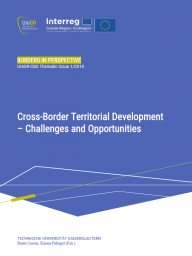Borders in Perspective Vol. 1

The spatial development of cities and regions is influenced by trends such as climate change, demographic shifts and structural change, which do not stop at administrative boundaries but shape the development of larger territories. Additionally, often functional and thematic interrelations exist across national borders that lead to frequent exchanges and interdependencies of territories and its citizens. Therefore, the coordination of the cross-border territorial development is crucial for a future-oriented and sustainable spatial development. Due to its great importance, this topic is examined from different perspectives by European scientists in the first issue of Borders in Perspective.
-
Foreword: Marie-Josée Vidal (MDDI Luxembourg)
-
Editorial: Karina Pallagst and Beate Caesar
-
Spatial Development Concepts – A cross-border planning instrument with a future?! Experiences from the German borderlands: Beate Caesar and Karina Pallagst
-
Cross-border territorial cooperation in non-EU member countries – Evidence from Albania and Switzerland: Alys Solly, Erblin Berisha and Giancarlo Cotella
-
Safeguarding services in health provision and health care in rural border areas – An investigation using the example of the Greater Region: Kirsten Mangels and Robert Riethmüller
-
Steering the cross-border transport development in the cross-border region between Brandenburg and Lubuskie: Beate Caesar
-
Spatial integration of cross-border mobility structures – The ‘space-time-line’ analysis in the Greater Region and the Czech-Bavarian border region: Tobias Chilla and Anna Heugel
-
The European Grouping of Territorial Cooperation: Challenges and Opportunities for the German-Polish cooperation – The case of the TransOderana EGTC (under construction): Peter Ulrich
